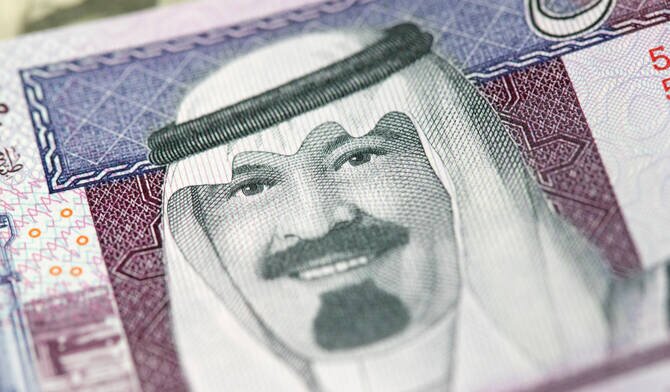
Saudi Arabia Leads GCC Debt Market with $47.9bn in H1 Issuances
Kuwait Financial Center report shows Saudi Arabia accounted for 52.1% of the total Gulf Cooperation Council issuances in the first half of 2025.
Riyadh: Saudi Arabia topped the Gulf region's primary debt market during the first half of 2025, raising $47.93 billion through 71 bond and sukuk issuances, according to a report from Kuwait Financial Center (Markaz).
The Kingdom accounted for 52.1% of the total Gulf Cooperation Council (GCC) issuances, solidifying its position as the region's dominant fixed income market.
However, this volume represented an 19.8% year-on-year decline compared to the first half of 2024 when $59.73 billion was raised through bond and sukuk sales.
The GCC primary debt market saw a total of $92.04 billion in issuances during the period, down 5.5% from the same period in 2024.
Fitch Ratings reported earlier this month that the region's outstanding debt exceeded $1 trillion.
Markaz noted an increased appetite for conventional bond issuances in the GCC, which represented 56.1% of total issuance in the first half.
This is a shift from 2024 when more sukuk were issued than conventional bonds.
The expansion of Saudi Arabia's domestic and international markets has driven the rapid growth of its debt market in recent years.
In July, the National Debt Management Center raised $1.34 billion through an increase in riyal-denominated sukuk sales compared to the previous month.
In February, the Kingdom issued €2.25 billion ($2.36 billion) in euro-denominated bonds, including its inaugural green tranche, under its Global Medium-Term Note Issuance Program.
Additionally, Saudi Arabia is expected to lead regional bond maturities over the next five years with an anticipated $168 billion in Saudi bond maturity between 2025 and 2029.
Following closely behind was the UAE with $24.03 billion raised from 69 issuances or 26.1% of total market share.
Qatar came in third, accounting for 10.9% of total GCC issuance in the first half with $10 billion through 58 offerings.
Bahrain saw a significant increase in its issuance volume and size, reaching $5.62 billion through seven deals, up 49.7% from the previous year.
Kuwaiti issuances increased by 48% to $3.39 billion from four transactions, while Oman's total remained the lowest at $1.08 billion from six issuances.
Bonds and sukuk with tenors under five years accounted for 46.9% of total GCC issuances, amounting to $43.2 billion across 154 deals.
Tenors between 5-10 years represented 33.8% of the market, totaling $31.1 billion from 43 deals.
Issuances with maturities ranging from 10-30 years comprised 9.6% and raised $8.8 billion through five transactions.
One issuance had a maturity greater than 30 years and accounted for $1 billion, while perpetual issuances saw an increase in size and number compared to the first half of last year with a total value of $8 billion from 12 issuances.
Currency-wise, US dollar-denominated instruments dominated the market raising $73.1 billion through 146 deals representing 79.4% of the total value.
The Saudi riyal was the second most used currency with $7 billion raised across eight transactions.
Corporate issuances in the GCC increased sharply to reach $60.2 billion and accounted for 65.4% of total issuance, while government-related entities contributed $11.2 billion through 11 deals.
Conventional bond issuances rose by 7.8% year-on-year to $51.61 billion, whereas sukuk issuances declined 18.2% over the same period totaling $40.43 billion.
The financial sector led issuance activity raising $40.1 billion from 167 deals or 43.6% of total issuance.
Government issuers followed with contributions amounting to $31.9 billion from 25 offerings.
The energy sector contributed $8.6 billion through nine transactions, while the remaining sectors collectively represented 12.5% of total issuance.
The Kingdom accounted for 52.1% of the total Gulf Cooperation Council (GCC) issuances, solidifying its position as the region's dominant fixed income market.
However, this volume represented an 19.8% year-on-year decline compared to the first half of 2024 when $59.73 billion was raised through bond and sukuk sales.
The GCC primary debt market saw a total of $92.04 billion in issuances during the period, down 5.5% from the same period in 2024.
Fitch Ratings reported earlier this month that the region's outstanding debt exceeded $1 trillion.
Markaz noted an increased appetite for conventional bond issuances in the GCC, which represented 56.1% of total issuance in the first half.
This is a shift from 2024 when more sukuk were issued than conventional bonds.
The expansion of Saudi Arabia's domestic and international markets has driven the rapid growth of its debt market in recent years.
In July, the National Debt Management Center raised $1.34 billion through an increase in riyal-denominated sukuk sales compared to the previous month.
In February, the Kingdom issued €2.25 billion ($2.36 billion) in euro-denominated bonds, including its inaugural green tranche, under its Global Medium-Term Note Issuance Program.
Additionally, Saudi Arabia is expected to lead regional bond maturities over the next five years with an anticipated $168 billion in Saudi bond maturity between 2025 and 2029.
Following closely behind was the UAE with $24.03 billion raised from 69 issuances or 26.1% of total market share.
Qatar came in third, accounting for 10.9% of total GCC issuance in the first half with $10 billion through 58 offerings.
Bahrain saw a significant increase in its issuance volume and size, reaching $5.62 billion through seven deals, up 49.7% from the previous year.
Kuwaiti issuances increased by 48% to $3.39 billion from four transactions, while Oman's total remained the lowest at $1.08 billion from six issuances.
Bonds and sukuk with tenors under five years accounted for 46.9% of total GCC issuances, amounting to $43.2 billion across 154 deals.
Tenors between 5-10 years represented 33.8% of the market, totaling $31.1 billion from 43 deals.
Issuances with maturities ranging from 10-30 years comprised 9.6% and raised $8.8 billion through five transactions.
One issuance had a maturity greater than 30 years and accounted for $1 billion, while perpetual issuances saw an increase in size and number compared to the first half of last year with a total value of $8 billion from 12 issuances.
Currency-wise, US dollar-denominated instruments dominated the market raising $73.1 billion through 146 deals representing 79.4% of the total value.
The Saudi riyal was the second most used currency with $7 billion raised across eight transactions.
Corporate issuances in the GCC increased sharply to reach $60.2 billion and accounted for 65.4% of total issuance, while government-related entities contributed $11.2 billion through 11 deals.
Conventional bond issuances rose by 7.8% year-on-year to $51.61 billion, whereas sukuk issuances declined 18.2% over the same period totaling $40.43 billion.
The financial sector led issuance activity raising $40.1 billion from 167 deals or 43.6% of total issuance.
Government issuers followed with contributions amounting to $31.9 billion from 25 offerings.
The energy sector contributed $8.6 billion through nine transactions, while the remaining sectors collectively represented 12.5% of total issuance.

